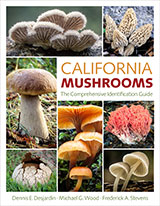The North American Species of Pholiota
40. Pholiota albovirescens sp. nov.
Pileus 0.8-3 cm latus, convexus, non viscidus, sericus, in medio "Naples yellow," tinctus viridi colore, marginibus "sea-foam green," cum maculis ferruginosis, margine planus. Caro albida demum flavida; odore mitis, gustu amarus. Lamellae adnatae cum dente decurrentes, albidae deinde "citron-green" demum "olive-green," brunnaceae, angustae, perconfertae. Stipes 3-5 cm longus, 2-5 mm crassus, concoloratus vel pallidior, base aeruginosus, flexuosus, sericus. Velum album, arachnoideum. Sporae 5.5-7.5 x 3.5-4 (4.5) µ, ellipsoideae demum subovoideae in fronte, parvum inaequilaterales in imagine obliqua, leves, truncatae. Pleurocystidia (16) 25-32 x 6-11 µ, clavata, mucronata; cheilocystidia 18-25 x 3-7 µ, clavata vel subventricosa demum ampullacea. Cuticula ex hyphis repentibus composita. Fibulae adsunt. Specimen typicum in Herb. Univ. Tenn.; legit prope Gatlinburg, Tennessee, 12, August 1965, Hesler 28185.
Pileus caespitose, 0.8-3 cm broad, convex, becoming more or less expanded, often obtusely umbonate, not viscid, subhygrophanous, silky, center "Naples yellow," tinged greenish, marginal half "seafoam green," with ferruginous stains, margin even, at times appendiculate. Context whitish or more or less concolorous; odor mild, taste bitter.
Lamellae adnate, with a decurrent tooth, at first whitish, becoming "citron-green" to "olive-green," brownish where bruised, finally brown from the spores, very crowded and narrow.
Stipe (1) 3-5 cm long, 2-5 mm thick, more or less concolorous with the pileus varying to straw colored, base becoming rusty brown, often compressed, flexuous, equal or attenuated upwards, silky, dry, hollow. Veil white, arachnoid, often leaving a faint ring, also remnants adhering for a time to pileus margin.
Spores 5.5-7.5 x 3.5-(4.5) µ, ellipsoid to subovoid in face view, slightly inequilateral in profile, smooth, truncate. Basidia 16-20 x 5-6 µ, 2- or 4-spored. Pleurocystidia (16) 25-32 x 6-11 µ, clavate-mucronate, rarely merely clavate, sometimes brownish, buried. Cheilocystidia 18-25 x 3-7 µ, clavate to subventricose, varying to fusoid-ventricose.
Gill trama subparallel, hyphae 3-6 µ broad; subhymenium not distinctive. Pileus trama of hyphae radially arranged to somewhat interwoven. Cuticle of pileus of radially arranged repent hyphae. Clamp connections present. All tissues inamyloid.
Habit, Habitat, and Distribution: On logs and buried wood of hardwoods, Tennessee, June-August.
Observations: The color-pattern suggested P. ochrochlora (Fr.) Orton, but this latter species has scales on the pileus disc and on the stipe, the gills are at first straw-yellow, the taste mild, pleurocystidia absent, and finally Orton in his description (1960) stated nothing about the spores being truncate. The species most similar to P. albovirescens is Naematoloma fasciculare but the color of the spore deposit and the inconspicuous pleurocystidia lacking a refractive content prevent assignment there.
Material Examined: TENNESSEE: Hesler 10399, 28185 (type).

